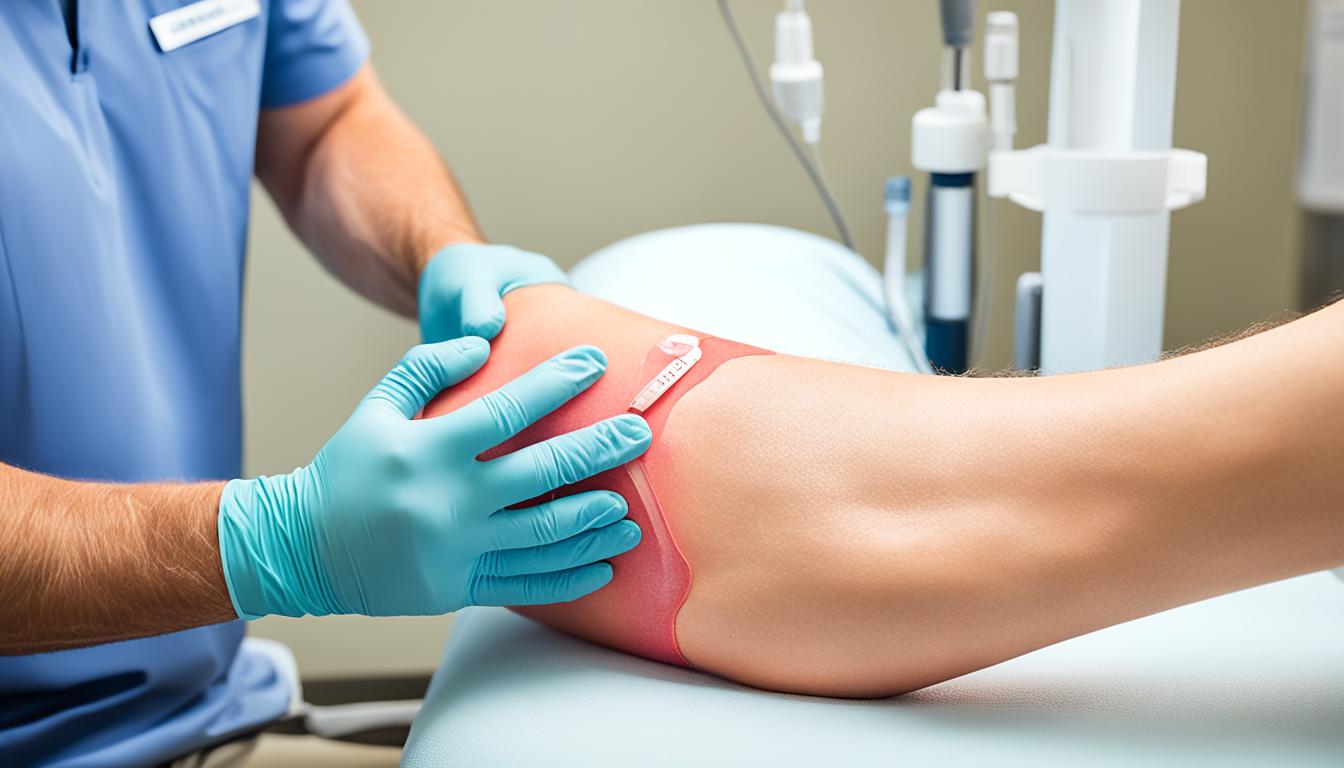Shin splints are also called medial tibial stress syndrome (MTSS). They happen when the shin bone and its surrounding muscles and tissues get overworked. It often occurs from doing too much high-impact like running, or starting new activities that stress the legs. Things like foot irregularities can cause shin splints too, making certain leg muscles work too hard.
Finding the root cause of shin splints is vital for their treatment. Things like wrong shoes and running on uneven ground can make it worse. This adds stress on the shin bone and muscles, causing pain and swelling.
Stem cell therapy is a new way to treat shin splints. It helps the body heal faster and decreases pain and swelling. Stem cells can repair damaged tissues, helping people with shin splints feel better.
Getting the right diagnosis from a doctor is critical for shin splint treatment. By tackling the main causes and using the right treatments, people can ease pain, heal, and avoid future problems.
Key Takeaways:
- Shin splints are due to too much stress on the shin’s bones and muscles.
- They can happen from intense activities or if shoes don’t fit right.
- Issues with how the leg is made can also play a part.
- Finding out exactly why you have shin splint is important for treating it.
- Stem cell therapy is a new, helpful way to treat shin splints.
Symptoms of Shin Splints
Shin splints cause pain in the shins when you start moving. This pain can get better or worse as you keep training. It’s usually on the front and inside part of the shin. You might feel it in one or both legs.
Other symptoms to watch out for include:
- Tenderness along the inner edge of the shinbone
- Swelling
- Mild redness
If you notice these symptoms, see a doctor. They can give you the right diagnosis and treatment.
Common Symptoms of Shin Splints
| Symptom | Description |
|---|---|
| Pain in the shins | Located at the beginning of activity, may worsen as training continues |
| Tenderness | Along the inner edge of the shinbone |
| Swelling | Visible swelling in the affected area |
| Mild redness | Redness along the front and inner side of the shinbone |
Causes and Risk Factors of Shin Splints
Shin splints, medically known as medial tibial stress syndrome (MTSS), happen for several reasons. One major cause is overuse and the stress from high-impact sports. These include running, basketball, and soccer. Repetitive movements in these sports strain the shin bone and its muscles.
If you suddenly push harder without preparation, shin splints can develop. It’s key to gradually enhance your training to avoid this. Your body needs time to adapt to increased intensity, duration, or frequency.
Biomechanical issues also play a part. Flat feet or high arches can make you more prone to shin splints. This is because it affects how your muscles work. Plus, bad running form, like overpronation, makes it worse. Choosing the wrong shoes, without good support, adds to the risk.
Other factors can make you more likely to get shin splints. A past issue with shin splints increases your risk again. Skipping a good warm-up or cool-down is also risky. Insufficient rest between workouts is another big factor.
Last, hard surfaces increase the stress on your legs, which can lead to shin splints.
Preventing Shin Splints
While you might not avoid shin splints completely, you can lower your risk. The right shoes are crucial. They should have plenty of cushioning and support. This helps lessen the impact on your legs.
Don’t forget to go easy when you’re starting or increasing your exercise. Your body needs time to get used to this. Also, never skip warming up or cooling down. This gets your muscles and joints ready and helps them recover.
Stretching and strengthening your lower leg muscles are also great prevention techniques. Always pay attention to your body. If your shins start hurting, don’t ignore it. See a doctor if you need to. Being proactive can keep you in the game, pain-free.
Conclusion
Shin splints are a common issue for runners. They bring pain and discomfort in the lower leg. It’s important to diagnose and treat them right to stop more problems.
You can treat shin splints with rest, ice, and stretching. You might also need to use shoe inserts or see a physical therapist. In some cases, surgery might be needed.
Stem cell therapy is also a new way to treat shin splints. It can help your body heal faster and lessen pain. Talk to a doctor to see if this is a good choice for you.
To avoid shin splints, wear the right shoes and slowly up your workout. Warm-ups and cool-downs are key too. If you think you have shin splints, see a doctor right away.

